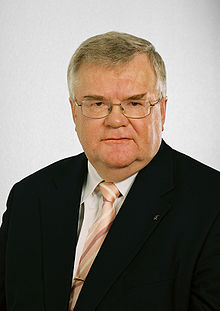Edgar Savisaar
| Edgar Savisaar | |
|---|---|
 |
|
| Mayor of Tallinn | |
|
In office 9 April 2007 – 30 September 2015 |
|
| Preceded by | Jüri Ratas |
| Succeeded by | Taavi Aas (ct) |
|
In office December 2001 – October 2004 |
|
| Preceded by | Tõnis Palts |
| Succeeded by | Tõnis Palts |
| Minister of the Interior | |
|
In office 13 April 2005 – 5 April 2007 |
|
| Preceded by | Margus Leivo |
| Succeeded by | Jüri Pihl |
| Acting Prime Minister of Estonia | |
|
In office 20 August 1991 – 29 January 1992 |
|
| President |
Arnold Rüütel (Chairman of the Supreme Council of the Republic of Estonia) Lennart Meri |
| Preceded by | Otto Tief (1944) |
| Succeeded by | Tiit Vähi |
| Personal details | |
| Born |
31 May 1950 Harku, Estonia |
| Political party |
Communist Party (1983–1988) Popular Front (1988–1991) Centre Party (1991–present) |
| Spouse(s) | Vilja Laanaru (1996–2009) |
| Children | 4 |
| Alma mater | University of Tartu |
Edgar Savisaar (born 31 May 1950), is an Estonian politician, one of the founding members of Popular Front of Estonia and the Centre Party. He has served as the acting Prime Minister of Estonia, Minister of the Interior, Minister of Economic Affairs and Communications and Mayor of Tallinn.
He was born in Vastse-Kuuste to Estonian father Elmar Savisaar and Russian mother Maria Burešin. In 1949 his parents wanted to leave the local kolkhoz with their livestock, this resulted in a physical conflict. Both were arrested on charges of seizing public property, tax evasion and an assault. Elmar Savisaar was sentenced 15 years (freed in 1952) and Marie Burešin 5 years (freed in 1950) in prison.
Marie Savisaar gave birth to Edgar Savisaar in Harku women's prison while serving the sentence. It has been theorized that Elmar Savisaar is not his biological father. The mother with the newborn was released the same year after being pardoned and they returned to Vastse-Kuuse.
After graduating from high school, Savisaar continued his studies at the University of Tartu. In 1973, he graduated from the university with a degree in history. In 1980, he wrote his candidate thesis in philosophy on the topic "Social Philosophical Foundations of the Global Models of the Club of Rome".
From 1980 to 1988, Savisaar worked in the Soviet Estonian governmental institutions dealing with the planning of economy. During 1988–1989, he was the academic director for the consultation company "Mainor".
In April he co-established the Popular Front (Rahvarinne) which became the first political mass organization in Soviet Union outside Communist Party after 1920. Initially formed to "support perestroika" Popular Front started increasingly develop ideas of Estonian national independence and created so called Singing Revolution phenomenon. The process with several others lead to dissolution of Soviet Union ultimately.
...
Wikipedia
